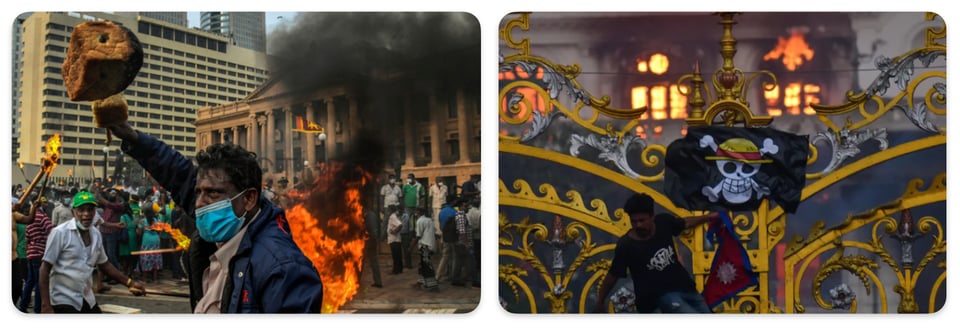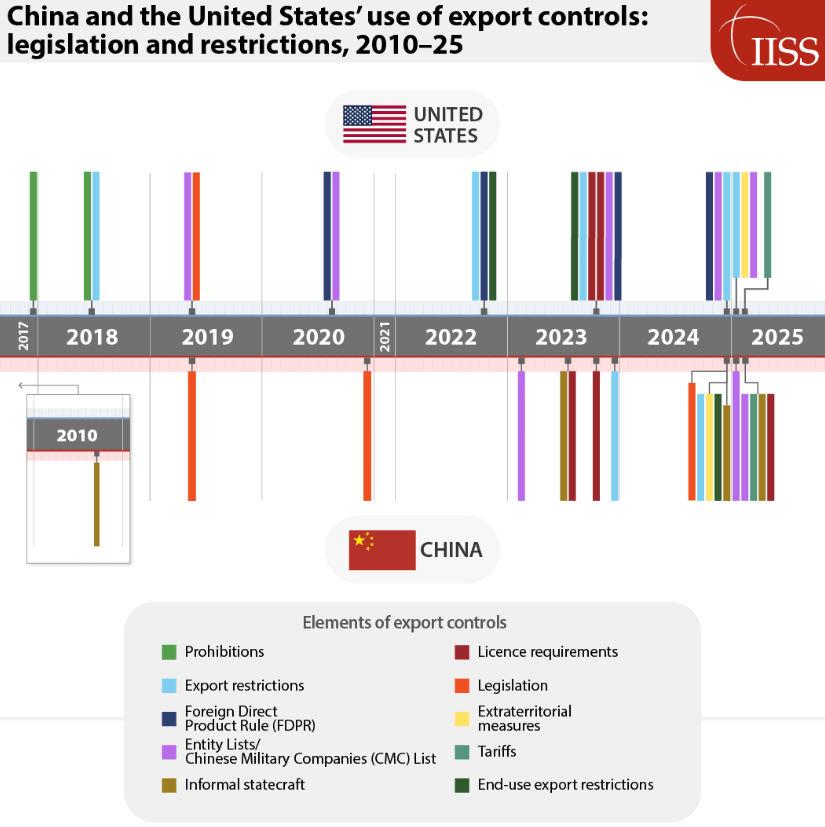China's 'all of the above'
Industrial supremacy, Gen Z protests, debt
Hello! We are finally getting answers to some of the questions that have been kicking around for years, like: “How hard might China really weaponize its near-monopoly of rare earths supplies?”.
China’s new export measures are about protecting not just its near monopoly on rare earths, but its entire tech and industrial landscape. That dovetails into a report that China’s next five-year plan will likely seek to make all its industries smarter and more technology advanced (and not relinquish any of the lower value ones).
Secondly: the Gen Z protests in multiple countries, which provides a more optimistic vision than the covid-and-food-fuel-price protests in Sri Lanka that we used to illustrate the very first Polycrisis essay on Phenomenal World — exactly three years ago:

Also: Our next book club will be Mark Blyth’s “Inflation: A guide for users and losers” and we are pretty optimistic that Mark will join us for a discussion. We don’t have a date yet, but the discord is here if you want to stay posted.
-Kate and Tim
All the rare earths
China’s new export controls announced earlier this month seeks to exert control of goods sold anywhere in the world that contain more than 0.1% (by value) of China-sourced rare earth materials. That is, almost every phone, battery, drone, fighter jet, Chinese authorities were at pains to say that these are not export bans; companies can seek permission. It doesn’t look good for most non-Chinese companies that deal in anything containing the designated materials, though. European companies have been having headaches with the less-extensive measures, affecting just a handful of rare earths, announced by China back in April. The new measure covers many more products details of complex supply chains and manufacturing processes are required. and only about half of applicants for export licences are successful. ““the level of detail required by the Chinese authorities is very excessive” and had become “unprocessable”” Europe’s trade commissioner said in the FT. It’s not clear if China will maintain this very broad stance for all countries; CSIS’s Gracelin Baskaran says the December 1 deadline means ample time for negotiation.
Either way, China’s actions almost mirror what the US has done in recent years with Foreign Direct Product Rule targeted at Huawei (under Trump 1.0) and then more broadly at Chinese chip customers (under Biden). Earlier, there were Defence procurement exclusions and export controls targeting ZTE to great effect (see the IISS diagram below).

Some of the reasons for China taking such a big step are obvious: retaliation for US tariffs and scaring up the Trump administration ahead of a meeting with Xi Jinping later this month.
But Kyle Chan writes that these sweeping restrictions might have a longer-term motivation, relating to China’s goal of a powerful and precise “unified export control system (统一的出口管制制度)”:
While recent US actions or upcoming negotiations between the two countries may have accelerated China’s efforts, China’s latest moves are ultimately part of a long-term push to build up an export control system that can fulfill a number of strategic goals:
Geopolitical leverage: developing tools of economic coercion to use against other countries
Technological control: retaining China’s technological edge in certain industries, like EV batteries, particularly as Chinese firms expand production overseas
National security: controlling military and dual-use items that can be used by potential adversaries
The “geopolitical” element Chan highlights is well known, and the defense and security goals have also been noted. The second objective he identifies, however, has been less discussed.
It’s important to note that there are also new barriers for countries wanting to reduce their dependence on China in the future'; no Chinese national is allowed to work on any part of a rare earths supply chain outside the country. China had already introduced controls over technologies for processing rare earths in 2023.
What China holds now is not just rare earths and processing facilities, but also integrated supply chains, knowhow, and an incredibly sophisticated base for manufacturing almost anything.
This chimes with observations from Pekingology, below, about the CPC central committee meeting this week: the Chinese government is in no way going to relinquish light manufacturing or low value-add; rather, it’s working on how to keep doing all of the above faster, and better.
New quality productive forces
China’s 15th five-year plan, which will run from 2026 - 2030, is being discussed this week. What comes out of it will signal the direction of the world’s most important economy that has an actual plan.
Pekingology on Monday said three themes were hinted at in ahead of the CPC committee meeting that runs this week. Highlighted is the second one:
First, Measures aimed at recalibrating the relationship between government and market—such as trimming excessive regulation and reducing market fragmentation—which Beijing describes as economic reforms.
Second, innovation in science and education, alongside upgraded manufacturing, is captured in the official term new quality productive forces. This signals a stronger focus on technology-driven industrial upgrading, from advanced chips and AI to robotics and clean energy vehicles, with education, talent, and research integrated into a single national strategy.
Third, improving public services through greater “investment in people” is portrayed as the next phase of common prosperity.
Gen Z has got this

Gen Z protest movements are building something of a track record of regime change (Bangladesh last year; Nepal and Madagascar this year) and at least policy change (Kenya). Not that you’d know it for the tiny amount of space they get in media coverage. There’s a lot going on right now but it’s hard to imagine that if Twitter was in its heyday, it wouldn’t be higher up the agenda.
Every country’s politics are unique, but there’s a few common threads.
“What connects these youth-led protests is a shared sense that traditional political systems aren’t responsive to their generation’s concerns, whether that’s corruption, climate change, or economic inequality. Protest then becomes the logical outlet when institutional channels feel blocked,” said Sam Nadel, director of Social Change Lab
from Associated Press.
Perhaps most of all is the sense of solidarity and shared social destiny; Moroccan Gen Z protesters were set off by the deaths of eight pregnant women in a month in one hospital; in Bangladesh, after Sheikh Hassina fled, students and other volunteers began manning traffic direction and creating neighbourhood safety watches.
There’s also a very online, common motif across the movements in multiple countries: a skull and crossbow from One Piece, the epic Japanese manga and anime series. Straw hat-wearing Luffy and his fellow pirates fight against a corrupt and oppressive regime.
“One Piece is well known around the world. It is a symbol of rebellion,” a Malagasy medical student who took place in protests last month told France24.
Globalisation lives on in culture, if nothing else?
It seems important that despite the turbo-charging of algorithms and the increasing use of politically suppressive internet controls, reasonably coordinated and effective movements of young people are taking place in middle- and lower-middle income countries in so many regions.
***
Annual meetings
The Annual Meetings of the World Bank and IMF were held in Washington DC. We didn’t see a lot of interesting things from it, except for a little (possible?) progress on debt.
The high servicing costs of sovereign debt has been a barrier for dozens of poor countries to expand access to clean energy; increase resilience to climate impacts, and just provide basic social welfare.
Five and a half years out from the alarm first being raised on sovereign debt distress, and the G20 and the private bondholders apparently might be maybe getting close to some kind of agreement on transparency in restructuring talks – which would speed up the process (debt restructuring talks tend to stagnate because no creditor wants to be taking a haircut when other creditors might be getting their repayment schedule in full).
From the progress report:
There is also broad support for, but not yet full consensus on, an earlier and more comprehensive publication by official creditor committees (OCCs) of the key terms of the restructuring, including reduction in net present value, once an agreement is reached. This would significantly facilitate the implementation of comparability of treatment (CoT) across creditors.
The same broad support, not yet full consensus applies to expanding the World Bank’s Data Sharing Exercise across all G20 creditors.
***
SOME OTHER LINKS AND LINES
“Imagine being marched by force through a desert with barely anything to drink while your captor repeatedly cools himself by dumping gallons of water on his head, and maybe you’ll start to get a sense of what it’s like to live in Texas these days.”
Parched Texas is giving away water to oil, gas and AI - Mark Gongloff, Bloomberg Opinion.
Advait Arun, our friend and sometime contributor, has a new email newsletter, Caravanserei, featuring short anonymised contributions about policy and political culture.
California has cracked the storage challenge (for the 4 hour window, at least). How mega-batteries are unlocking an energy revolution, FT
China’s presence in African news media is… extensive:
“Ambassador Guo Haiyan’s column appeared on the same day in all three of the country’s leading dailies. That’s The Star, Daily Nation, and The Standard. And it just gives you an indication of the kind of full court press that the Chinese are pushing in terms of promoting the GGI.” sEric Olander, China Global South podcast
Common-Wealth’s new Transition Security Project looks to revive and renew efforts of the Cold War era to “use public investment to divert manufacturing from superfluous military production and towards the security of working people”.
Add a comment: